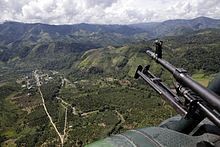Valle de los Ríos Apurímac, Ene y Mantaro




The Valle de los Ríos Apurímac, Ene y Mantaro (lit. 'Valley of the Apurímac, Ene and Mantaro rivers'), also known as the VRAEM or VRAE, is a geopolitical area in Peru.[1] It is one of the major areas of coca production in Peru.[2] The area is extremely poor.[2]
The VRAEM is an area of such high childhood malnutrition and poverty that the government of Peru selected the VRAEM to launch its program in 2007.[3]
Cocaine production[]
Since 2012, Peru has overtaken Colombia as the world's largest cocaine-producing country.[4][5] With local incomes below $10/day, the valleys are used to produce raw paste product, and much of the drug trade is controlled by the Shining Path.[5][6] With an estimated 19,700 hectares (49,000 acres) of production area (2010), it is presently the world's densest area of cocaine production.[1][6] Paste product is shipped out of the valleys by armed native backpackers to Cuzco,[2][5] and then onward shipped to either: the Pacific Ocean ports; the Bolivian border, where it is sold to one of the drug cartels; or to mule-traffickers who ship the product onwards via scheduled air transport to Europe and North America.[5][6]
References[]
- ^ a b "Slaves of the past". The Economist. 1 August 2015. Retrieved 3 August 2015.
- ^ a b c Pressly, Linda (24 November 2015). "The Mochileros". BBC News. Retrieved 24 November 2015.
- ^ "Crecer ya está en el VRAE". Comisión Interministerial de Asuntos Sociales. 21 December 2007. Retrieved 14 November 2009.
- ^ "Part 5. Peru Coca Cultivation Survey" (PDF). Peru Coca Survey for 2005. United Nations Office on Drugs and Crime. Retrieved 14 November 2009.
- ^ a b c d https://www.nytimes.com/aponline/2015/05/07/world/americas/ap-lt-peru-cocaine-backpackers.html?_r=0. Retrieved 24 November 2015. Missing or empty
|title=(help)[dead link] - ^ a b c Collyns, Dan (23 June 2011). "Peru's challenge to tackle cocaine trade". BBC News. Retrieved 26 November 2015.
See also[]
Coordinates: 11°42′S 74°00′W / 11.7°S 74.0°W
- Geography of Peru
- Cocaine
- Poverty in Peru
- Peru geography stubs
